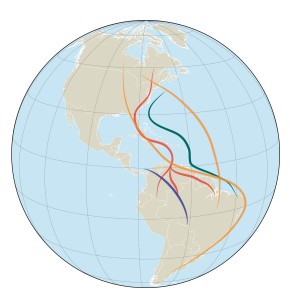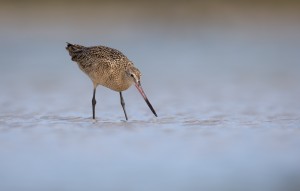By Debra Reynolds

Each year shorebirds use habitats across a vast geography, undertaking some of the longest migrations of any animals on earth. Within the Atlantic Flyway, many shorebird species breed on the Canadian Arctic tundra during summer, and then fly south in the fall to winter along the eastern shores of South America. During this international flight, they stop at several critical sites like the Delaware Bay and Caribbean Islands. While there, they rest and refuel to survive the long journey. Unfortunately, many of these shorebird populations are in trouble.
Atlantic Flyway shorebirds are exposed to a diverse set of human-induced threats like habitat loss and change, hunting in the Caribbean, and predators. Effective shorebird conservation thus requires a wide-ranging approach to identify and reduce these threats at sites all along the flyway. Such an approach must involve coordinated research, conservation, and management efforts among many groups and across many political boundaries. It must consolidate resources and target them to priority sites and actions to ensure efficient and effective conservation. Only with such a flyway-scale approach can we reverse the serious declines we are witnessing in many of our shorebird populations.

The Atlantic Flyway Shorebird Conservation Business Strategy is an unprecedented endeavor to implement conservation for shorebirds across an enormous geographic scale. It emphasizes the involvement of scientists, advocates, funders, and conservation practitioners all working together to carry out the most important actions to achieve specific, measurable outcomes for shorebirds. In this way, the strategy presents the needs, actions, and people that can recover this remarkable suite of species.
The strategy addresses the most serious human-induced threats known to affect shorebirds and their habitats in the Atlantic Flyway —one such threat is hunting at Caribbean and South American stopover and wintering sites. In 2011, Machi and Goshen, two satellite-tagged Whimbrels were shot by hunters in Guadeloupe after circumventing two hurricanes. This watershed event elevated international attention to the plight of shorebirds from hunting throughout the Caribbean and beyond.

Partners to the Atlantic Flyway Shorebird Conservation Business Strategy have been working together to improve shorebird harvest policy and regulations to thoroughly address the issue of shorebird harvest in the Caribbean and Latin America. For example, the U.S. Fish & Wildlife Service was awarded a grant for $250,000 from the National Fish & Wildlife Foundation to help manage the hunt of high priority shorebirds in the Caribbean and northern South America.
The enormous task of reversing serious declines in shorebird populations can feel daunting at times. However, inspiration can be gained through stories of partners “called to action.” For instance, a highly focused partnership has been working for several years to restore American Oystercatcher populations. According to Jeff Trandahl, Executive Director and CEO of the National Fish & Wildlife Foundation, “The results have been nothing short of remarkable. It appears oystercatcher numbers have increased 4% in just 48 months. As wildlife professionals know, a reversal of this magnitude during such a short time span is rarely seen.”
This success story reminds us that partners can coordinate their efforts across the full range of species to recover their populations— it is possible. And having a guiding document like the Atlantic Flyway Shorebird Conservation Business Strategy makes the job a little easier. Creating a safe highway for travelling shorebirds is within our grasp.
For more information on the Atlantic Flyway Shorebird Conservation Business Strategy contact Scott_Johnston@fws.gov. To see the full strategy, visit this site.
– Debra Reynolds
Division of Migratory Birds
U.S. Fish and Wildlife Service


